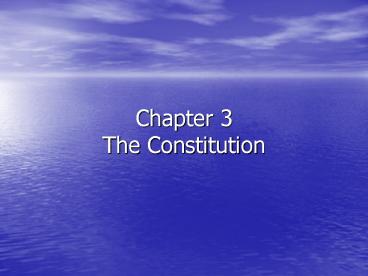Chapter 3 The Constitution - PowerPoint PPT Presentation
1 / 17
Title:
Chapter 3 The Constitution
Description:
Chapter 3 The Constitution Section 1 The Six Basic Principles An Outline of the Constitution 7,000 words Few details Organized in a simple straightforward way. – PowerPoint PPT presentation
Number of Views:70
Avg rating:3.0/5.0
Title: Chapter 3 The Constitution
1
Chapter 3The Constitution
2
Section 1The Six Basic Principles
- An Outline of the Constitution
- 7,000 words
- Few details
- Organized in a simple straightforward way.
- Eloquent Preamble
- 7 Articles
- 1-3 establish the 3 branches
- 4 deals with the states
- 5 is about amendments
- 6 deals with It as Supreme Law
- 7 deals with ratification
3
Section 1The Six Basic Principles
- The Basic Principles
- Popular Sovereignty
- The people are sovereignthe only source of
power. - Government can ONLY govern with the consent of
the governed.
4
Section 1The Six Basic Principles
- The Basic Principles (cont.)
- Limited Government
- No government is all powerful.
- Sometimes called Constitutionalism
- Sometimes called the Rule of Law
- All are subject to but never above the Law.
- The Constitution clearly limits government
- Includes the Great Guarantees
- Freedom of religion, speech, press, assembly and
petition.
5
Section 1The Six Basic Principles
- The Basic Principles (cont.)
- Separation of Powers
- In contrast to the Parliamentary System where all
power resides in the Parliament. - Article ILegislative Power
- Article IIExecutive Power
- Article IIIJudicial Power
- Separation of powers is intended to limit
government
6
Section 1The Six Basic Principles
- The Basic Principles (cont.)
- Checks and Balances
- Numerous
- No branch operates independently.
- Veto is a good example
7
Section 1The Six Basic Principles
- The Basic Principles (cont.)
- Judicial Review
- Constitutional vs. unconstitutional.
- The case of Marbury vs. Madison in 1803.
- Landmark case to establish Judicial Review
- Federalism
- Division of power between national and states
- Motivated by experience in Articles and colonial
era. - A Great Compromise
8
Section 2Formal Amendment
- 4 million to 290 million
- 13 colonies to 50 states
- Constitution is NOT the same now as in 1787.
9
Section 2Formal Amendment
- Formal Amendment Process
- Article V
- Proposal by 2/3 of each house of Congress to be
ratified by 3/4 of states (38). - This method has been used 26 out of 27 amendments
- Proposal by 2/3 of each house and a call for
conventions in the states. Then approved by 3/4
of states (38). - Only used once on the 21st amendment in 1933.
- Call from 2/3 of state legislatures (34) for a
national convention to consider amendment. It
must then be ratified by 3/4 of states (38).
Never used. - An amendment may be proposed by a national
convention and then ratified in 3/4 of state
conventions (38). Never used.
10
Section 2Formal Amendment
- Formal Amendment Process (cont.)
- Federalism and Popular Sovereignty
- Approval process reinforces federalism and
indirectly sovereignty. - Sometimes criticized as being representative and
not direct. - The state legislature must act first.
11
Section 2Formal Amendment
- Formal Amendment Process (cont.)
- Proposed Amendments
- No state may be deprived of its representation in
the Senate. - The President is NOT involveddoes not sign.
- If rejected by a state it may later be
reconsidered, once approved, however, it is
final. - 10,000 amendment proposals have been submitted.
- Only 33 have been sent to the states and only 27
ratified.
12
Section 2Formal Amendment
- Formal Amendment Process (cont.)
- Proposed Amendments (cont.)
- 10,000 amendment proposals have been submitted.
- Only 33 have been sent to the states and only 27
ratified. Six failed - One proposed in 1789 with the Bill of Rights
died. - One offered in 1789 became the 27th
(Congressional Compensation). - 1810-foreign titles void citizenship.
- 1861-no slavery amendments.
- 1924 an act to regulate child labor.
- 1972 Equal Rights Amendment by 1984 fell short.
- 1978 representation for the District of Columbia
- A 7 year time limit for enactment started in 1917
(ERA in 1979 was given a 3 year extension).
13
Section 2Formal Amendment
- The 27 Amendments
- The Bill of Rights
- Proposed in 1789ratified by 1791.
- The Later Amendments
- The 12th corrected a electoral college problem
after the election of 1800. - The 13th abolished slavery in 1865, the 14th
granted citizenship to blacks in 1868, and in
1870 the 15th granted the right to vote to blacks.
14
Section 2Formal Amendment
- The 27 Amendments (cont.)
- The Later Amendments (cont.)
- The 18th in 1919 prohibited alcohol and was
repealed by the 21st in 1933.. - The 19th in 1920 granted women the vote.
- The 22nd in 1951 limited the presidency to two
terms. - The 25th in 1967 deals with presidential
succession. - The 26th in 1971 granted the vote to all over 18.
- The 27th in 1992 prohibits congressional raises
during the current term.
15
Section 3Constitutional Change by Other Means
- Basic Legislation
- Expanded into the detail
- Tens of thousands of laws
- Executive Action
- Commander in Chief
- Executive Agreementused frequently now
- Treatycumbersome process
16
Section 3Constitutional Change by Other Means
- Court Decisions
- Marbury v. Madison in 1803
- A constitutional convention in continuous
session - Party Practices
- Not in the beginningWashington warned against.
- Party Conventions
- Electoral College
17
Section 3Constitutional Change by Other Means
- Custom
- Unwritten
- Cabinet
- Vice President role developed
- Senatorial courtesya nominee must be acceptable
in home state. - No third-term for 150 years

